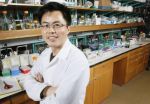This study's findings, published in PLoS ONE, represents a new approach to treating these related, and serious, red blood cells disorders, say the investigators.
"This gene therapy technique has the potential to cure many patients, especially if we prescreen them to predict their response using just a few of their cells in a test tube," says the study's lead investigator, Dr. Stefano Rivella, Ph.D., an associate professor of genetic medicine at Weill Cornell Medical College. He led a team of 17 researchers in three countries.
Dr. Rivella says this is the first time investigators have been able to correlate the outcome of transferring a healthy beta-globin gene into diseased cells with increased production of normal hemoglobin -- which has long been a barrier to effective treatment of these disease.
So far, only one patient in France has been treated with gene therapy for beta thalassemia, and Dr. Rivella and his colleagues believe the new treatment they developed will be a significant improvement. No known patient has received gene therapy yet to treat sickle cell anemia.
A Fresh Approach to Gene Therapy
Beta-thalassemia is an inherited disease caused by defects in the beta-globin gene. This gene produces an essential part of the hemoglobin protein, which, in the form of red blood cells, carries life-sustaining oxygen throughout the body.
The new gene transfer technique developed by Dr. Rivella and his colleagues ensures that the beta-globin gene that is delivered will be active, and that it will also provide more curative beta-globin protein. "Since the defect in thalassemia is lack of production of beta-globin protein in red blood cells, this is very important," Dr. Rivella says.
The researchers achieved this advance by hooking an "ankyrin insulator" to the beta-globin gene that is carried by a lentivirus vector. During the gene transfer, this vector would be inserted into bone marrow stem cells taken from patients, and then delivered back via a bone marrow transplant. The stem cells would then produce healthy beta-globin protein and hemoglobin.
This ankyrin insulator achieves two goals. First, it protects delivery of the normal beta-globin gene. "In many gene therapy applications, a curative gene is introduced into the cells of patients in an indiscriminate fashion," Dr. Rivella explains. "The gene lands randomly in the genome of the patient, but where it lands is very important because not all regions of the genome are the same." For example, some therapeutic genes may land in an area of the genome that is normally silenced -- meaning the genes in this area are not expressed. "The role of ankyrin insulator is to create an active area in the genome where the new gene can work efficiently no matter where it lands," Dr. Rivella says. He adds that the small insulator used in his vector should eliminate the kind of side effects seen in the French patient treated with beta-thalassemia gene therapy.
The research team also discovered that the insulator increases the efficiency by which the beta-globin gene is transcribed during the process of making the red blood cells. "We found the gene is integrated into cells which have not yet begun to make red blood cells, and when they do, the beta-globin gene is activated," Dr. Rivella says. "We showed that if the insulator is present, activation of the curative gene is more efficient. This provides more curative protein to red blood cells."
The study further provides evidence that the vector had different rates of efficiency depending on the beta-thalassemia mutation it was used in -- thus providing the basis for a predictive test in patients. The investigators tested 19 different beta-thalassemia samples comprising the two types commonly found in patients -- "beta-zero" cells that do not produce any beta-globin (forcing patients to receive blood transfusions throughout life), and "beta-plus" cells that produce suboptimal levels of hemoglobin. On average, they found that one copy of the vector in beta-zero cells produced 55 percent of the adult hemoglobin seen in normal individuals. Beta-plus cells, after treatment, produced hemoglobin comparable to a healthy individual, and were thus cured.
"The variable nature of the beta-thalassemia mutations suggests that some patients would be better candidates for gene therapy than others, and that success of gene therapy depends on the ability of a specific vector to make hemoglobin," Dr. Rivella says. "This is something we can test in advance using a little bit of a patient's blood -- which is quite extraordinary."
The issue in sickle cell anemia is very different, Dr. Rivella says. The hemoglobin protein is made in the right quantities, but it is not normal -- the red cell is shaped like a sickle and is abnormal in function. "One of the problem in gene therapy of sickle cell anemia is to add a new gene without increasing too much the total amount of protein, both normal and sickle. This would cause other problems," he says.
By treating eight cell specimens taken from sickle cell anemia patients, the investigators discovered that attaching the ankyrin insulator to a normal beta-globin gene increases the amount of normal beta globin protein while reducing the quantity of sickled protein. "The total amount of protein stays the same, which is very important," says first author Dr. Laura Breda, pediatric research associate at Weill Cornell Medical College.
The researchers say that their advances will likely make a substantial impact on a number of fields, including gene regulation and transfer and the design of gene therapy trials. "This study represents a fresh departure from previously published work in the field of gene therapy," Dr. Rivella says. The PLoS ONE article may be found online at http://dx.plos.org/10.1371/journal.pone.0032345 after the embargo lifts.
###
The study was funded by the Cooley's Anemia Foundation (CAF), the Veneta Association for the Fight Against Thalassemia (Italy), the Carlo and Micol Schejola Foundation, the Children's Cancer and Blood Foundation, the Clinical and Translational Science Center, the Carlo and Micol Schejola Foundation, Telethon, and grants from the National Institutes of Health.
Co-authors include: Laura Breda, Carla Casu, Sara Gardenghi, Dorothy A. Kleinert, Robert W. Grady, and Patricia J. Giardina (Weill Cornell Medical College); Nicoletta Bianchi, and Roberto Gambari, from Universita' di Ferrara, Ferrara, Italy; Luca Cartegni, from Memorial Sloan Kettering Cancer Center; Mohandas Narla, Karina Yazdanbakhsh, from the New York Blood Center; Marco Musso, from Ospedali Galliera, Genova, Italy; Deepa Manwani, from the Albert Einstein College of Medicine; Jane Little, from Montefiore Medical Center; Lawrence B. Gardner, from New York University, and Eugenia Prus, and Eitan Fibach, from Hadassah–Hebrew University Medical Center, Jerusalem, Israel.
Weill Cornell Medical College
Weill Cornell Medical College, Cornell University's medical school located in New York City, is committed to excellence in research, teaching, patient care and the advancement of the art and science of medicine, locally, nationally and globally. Physicians and scientists of Weill Cornell Medical College are engaged in cutting-edge research from bench to bedside, aimed at unlocking mysteries of the human body in health and sickness and toward developing new treatments and prevention strategies. In its commitment to global health and education, Weill Cornell has a strong presence in places such as Qatar, Tanzania, Haiti, Brazil, Austria and Turkey. Through the historic Weill Cornell Medical College in Qatar, the Medical College is the first in the U.S. to offer its M.D. degree overseas. Weill Cornell is the birthplace of many medical advances -- including the development of the Pap test for cervical cancer, the synthesis of penicillin, the first successful embryo-biopsy pregnancy and birth in the U.S., the first clinical trial of gene therapy for Parkinson's disease, and most recently, the world's first successful use of deep brain stimulation to treat a minimally conscious brain-injured patient. Weill Cornell Medical College is affiliated with NewYork-Presbyterian Hospital, where its faculty provides comprehensive patient care at NewYork-Presbyterian Hospital/Weill Cornell Medical Center. The Medical College is also affiliated with the Methodist Hospital in Houston. For more information, visit weill.cornell.edu.
END



